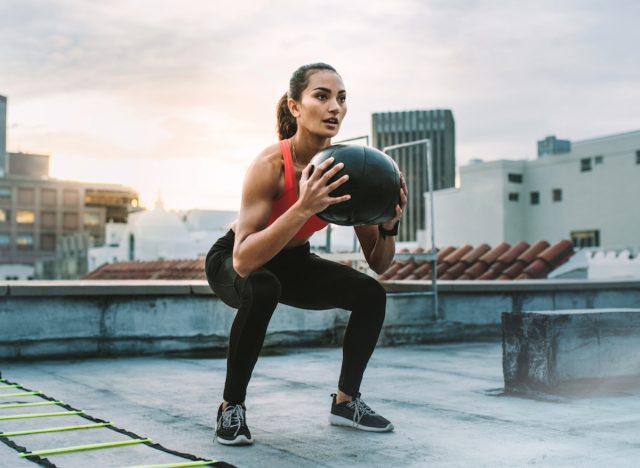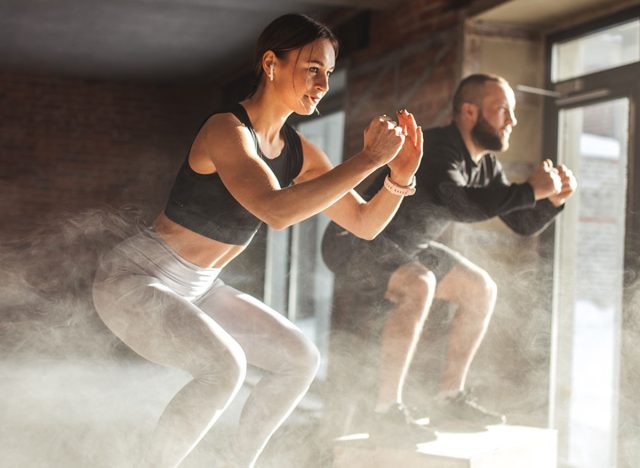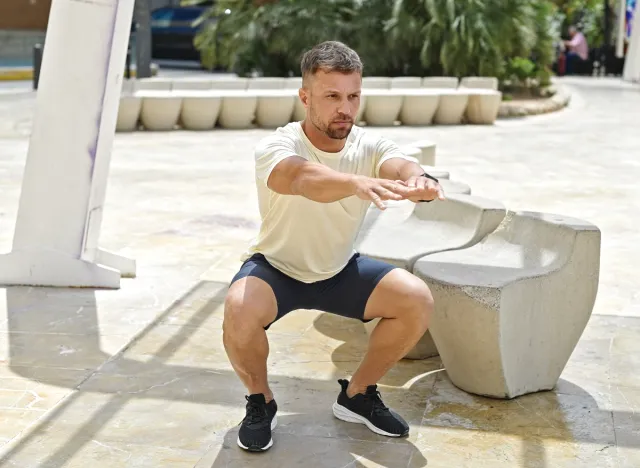What’s not to love about squats? In one seamless exercise, you’ll find many effective squat variations and even more benefits. From increasing strength and muscle size to improving endurance and mobility, squats are often leaned on as one of the more potent options for crushing your goals in the gym.
Whether you’re a beginner, intermediate, or advanced lifter, there’s a squat variation that can help you reach your fitness goals. In this article, I’ll explore 10 different squat variations, breaking down the unique benefits of each and providing step-by-step instructions to ensure you get the most out of your workout.
I have something for everyone, from bodyweight squats to advanced pistol squats. Get ready to find the perfect squat variation to elevate your fitness routine!
Why Squats are a Beneficial Exercise

Squats are often hailed as one of the most effective exercises for overall fitness, and for good reason. They engage multiple muscle groups, including the quadriceps, hamstrings, glutes, and core, making them a highly efficient compound movement. This means that by performing squats, you’re building strength in your legs and enhancing stability and endurance throughout your entire body.
The functional nature of squats mirrors everyday movements like sitting, standing, and lifting, which translates to improved performance in daily activities and sports.
In addition to building muscle and strength, squats offer significant benefits for joint health and mobility. The deep bending and straightening of the knees and hips during a squat enhance these joints’ flexibility and range of motion. This can lead to better posture, reduced risk of injury, and greater ease in performing various physical tasks.
Moreover, squatting regularly helps maintain bone density, which is crucial for preventing osteoporosis and other age-related bone issues.
How to Choose the Right Squat Variation for You

Choosing the right squat variation is crucial for optimizing your workout and achieving your fitness goals. Whether you aim to build strength, increase muscle size, lose weight, or develop power, a squat variation can help you get there. Here’s how to choose the right one for you.
1. Define your goals.
Strength: If your primary goal is to build strength, focus on heavy, compound movements like the back squat or front squat. These variations allow you to load more weight and engage multiple muscle groups, making them ideal for strength development.
Size (Hypertrophy): Consider variations like the goblet squat or Bulgarian split squat to increase muscle size. These exercises provide a good mix of load and range of motion, promoting muscle growth.
Weight Loss: Opt for high-repetition, full-body movements like the jump squat or thruster for weight loss. These exercises increase your heart rate and burn more calories, making them effective for fat loss.
Power Development: If power is your goal, incorporate explosive movements such as the box squat or back squat, using sub-maximal loads, focusing on speed. These variations improve your ability to generate force quickly, which is essential for athletic performance.
2. Assess your fitness level and experience.
Beginner: If you’re new to squatting, start with easier to perform variations requiring less balance and coordination. The bodyweight squat or goblet squat is great for beginners as it helps develop proper form and technique.
Intermediate: Once you’ve mastered the basics, you can progress to more challenging variations like the front squat or Bulgarian split squat. These exercises require more stability and strength, providing a greater challenge.
Advanced: Experienced lifters can incorporate complex movements like the pistol squat or overhead squat. These variations demand high levels of strength, balance, and mobility and offer a rigorous workout for advanced trainees.
3. Consider your mobility.
Proper mobility is essential for performing squats safely and effectively. If you have limited ankle or hip mobility, start with variations that require a smaller range of motion, such as the box squat or goblet squat. Gradually improve your mobility through stretching and mobility exercises to progress to deeper and more challenging squat variations.
4. Plan for progression.
To continue making gains, it’s important to vary your squat routine and progressively increase the difficulty. Start with simpler variations and gradually move to more complex ones as your strength and technique improve. For example, you might begin with bodyweight squats, progress to goblet squats, and eventually incorporate front squats and pistol squats into your routine.
10 Different Squat Variations and What Fitness Level Each is Most Beneficial For

Squats are one of the most versatile exercises, perfect for beginners to advanced athletes. Each type of squat brings its own set of benefits, hitting different muscle groups and helping you reach various fitness goals.
In this section, we’ll explore 10 different squat variations. I’ll explain what makes each one special and give you step-by-step instructions on how to do them right. I’ll also include some recommended sets and reps to ensure you get the most out of these moves in your workout routine.
Beginners
Starting with these squat variations helps build a solid foundation. Focus on mastering form and technique to prevent injury and ensure smooth progression to more advanced movements.
Variation #1: Bodyweight Squat
The bodyweight squat is an excellent starting point for beginners, as it allows you to master the basic squatting motion without any added resistance. This variation focuses on building foundational strength, improving balance, and enhancing mobility in the hips, knees, and ankles. By perfecting the bodyweight squat, you’ll establish a solid base that will support more advanced squat variations in the future.
To perform this exercise, stand with your feet shoulder-width apart and your toes slightly turned out. Keep your chest up and your core engaged. Begin by pushing your hips back as if you are sitting in a chair, then bend your knees to lower your body until your thighs are parallel to the floor. Ensure your knees track over your toes and avoid letting them collapse inward. Push through your heels to return to the starting position.
Aim for three sets of 15 to 20 reps, with 60 to 90 seconds of rest between sets.
Variation #2: Goblet Squat
The goblet squat is a beginner-friendly variation that adds a bit of resistance while helping you maintain proper form. Holding a dumbbell or kettlebell close to your chest, this exercise encourages an upright torso and can improve upper body strength and stability. Introducing light weights is also a great way to progress from bodyweight squats.
Hold a dumbbell or kettlebell close to your chest with both hands, keeping your elbows tucked in. Stand with your feet shoulder-width apart and your toes slightly turned out. Begin by pushing your hips back and bending your knees to lower your body into a squat. Keep your chest lifted and ensure your knees track over your toes. Lower until your thighs are parallel to the floor, then push through your heels to return to the starting position.
Perform three sets of 12 to 15 reps, with 60 to 90 seconds of rest between sets.
Variation #3: Dumbbell Front Squat
The dumbbell front squat is an excellent introduction to weighted squats. It provides a balanced load that helps improve core stability and upper-body strength. Holding dumbbells at shoulder height shifts the center of gravity slightly forward, engaging the core muscles more intensely and promoting better posture.
To perform a dumbbell front squat, hold a pair of dumbbells at shoulder height with your palms facing each other. Stand with your feet shoulder-width apart and your toes slightly turned out. Keep your chest up and core engaged as you push your hips back and bend your knees to lower into a squat. Ensure your elbows remain high and your knees track over your toes. Lower until your thighs are parallel to the floor, then push through your heels to return to the starting position.
Aim for three sets of 10 to 12 reps, with 60 to 90 seconds of rest between sets.
Intermediate
Intermediate lifters can start incorporating heavier weights and more complex movements. Focus on maintaining good form while gradually increasing the load to continue building strength and muscle.
Variation #4: Barbell Back Squat
The barbell back squat is a staple in strength training. It targets the lower body and core while allowing for heavier loads. This variation engages the glutes, hamstrings, quadriceps, and lower back, making it a powerful exercise for building overall strength and muscle mass.
To perform a barbell back squat, position a barbell across your upper back, just below the neck, with your hands gripping the bar slightly wider than shoulder-width apart. Stand with your feet shoulder-width apart and your toes slightly turned out. Keep your chest up and core engaged as you push your hips back and bend your knees to lower into a squat. Lower until your thighs are parallel to the floor or slightly below, then push through your heels to return to the starting position.
Perform three to four sets of six to eight reps, with two to three minutes of rest between sets.
Variation #5: Barbell Front Squat
The barbell front squat shifts the load to the front of the body, increasing the demand on the quadriceps and core. This variation also promotes an upright torso, enhancing upper-body strength and stability. It’s particularly beneficial for improving posture and building balanced leg development.
To perform this exercise, position a barbell across the front of your shoulders, resting it on your deltoids and clavicles. Cross your arms over the bar or use a clean grip, keeping your elbows high. Stand with your feet shoulder-width apart and your toes slightly turned out. Keep your chest up and core engaged as you push your hips back and bend your knees to lower into a squat. Lower until your thighs are parallel to the floor, then push through your heels to return to the starting position.
Aim for three to four sets of six to eight reps, with two to three minutes of rest between sets.
Variation #6: Pause Squat
The pause squat adds an element of control and time under tension, enhancing strength and stability in the lower body. By pausing at the bottom of the squat, you force your muscles to work harder to maintain the position, leading to increased muscle activation and growth.
To perform this exercise, use a barbell in either the back squat or front squat position. Stand with your feet shoulder-width apart and your toes slightly turned out. Push your hips back and bend your knees to lower into a squat. Once you reach the bottom position, hold for two to three seconds before pushing through your heels to return to the starting position. Ensure you maintain proper form throughout the pause.
Perform three sets of five to seven reps, with two to three minutes of rest between sets.
Variation #7: Overhead Squat
The overhead squat is a challenging variation that requires excellent mobility, stability, and coordination. Holding a barbell overhead engages the entire body, particularly the shoulders, core, and upper back, making it an effective exercise for developing overall athleticism and functional strength.
Hold a barbell overhead with a wide grip to perform this move, keeping your arms fully extended. Stand with your feet shoulder-width apart and your toes slightly turned out. Keep your chest up and core engaged as you push your hips back and bend your knees to lower into a squat. Ensure the barbell remains directly overhead and your elbows are locked out. Lower until your thighs are parallel to the floor, then push through your heels to return to the starting position.
Aim for three sets of five to seven reps, with two to three minutes of rest between sets.
Advanced
Advanced lifters can benefit from incorporating complex movements challenging their strength, stability, and mobility. To continue making gains, focus on perfecting the technique and progressively increasing the difficulty.
Variation #8: Eccentric Back Squat
The eccentric back squat emphasizes the lowering phase of the movement, enhancing muscle control and strength. Slowing down the descent increases time under tension, which promotes muscle hypertrophy and improves technique.
To perform an eccentric back squat, position a barbell across your upper back, just below the neck, with your hands gripping the bar slightly wider than shoulder-width apart. Stand with your feet shoulder-width apart and your toes slightly turned out. Lower into a squat slowly, taking three to five seconds to reach the bottom position. Push through your heels to return to the starting position. This controlled lowering phase intensifies the workout.
Perform three sets of four to six reps, with two to three minutes of rest between sets.
Variation #9: Zercher Squat
The Zercher squat involves holding the barbell in the crook of your elbows, shifting the load to the front of the body. This variation engages the upper body and core more intensely while also challenging the lower body. It’s particularly useful for improving posture and enhancing overall functional strength.
To perform a Zercher squat, position a barbell in the crook of your elbows, holding it securely with your arms bent. Stand with your feet shoulder-width apart and your toes slightly turned out. Keep your chest up and core engaged as you push your hips back and bend your knees to lower into a squat. Lower until your thighs are parallel to the floor, then push through your heels to return to the starting position.
Aim for three sets of six to eight reps, with three to four minutes of rest between sets.
Variation #10: Pistol Squat
The pistol squat is a demanding single-leg squat variation that requires significant strength, balance, and flexibility. It effectively targets the quadriceps, glutes, and core while also improving unilateral strength and coordination. This advanced movement is excellent for enhancing athletic performance and lower-body stability.
To perform a pistol squat, stand on one leg with the other leg extended straight in front of you. Keep your chest up and core engaged as you push your hips back and bend your knee to lower into a squat on the supporting leg. Lower until your thigh is parallel to the floor or slightly below, then push through your heel to return to the starting position. Ensure you maintain balance and control throughout the movement.
Perform three sets of three to five reps per leg, with two to three minutes of rest between sets.










